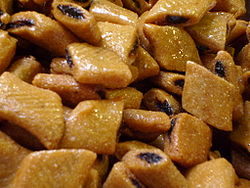


Makroudh covered in honey
| |
| Type | Cookie |
|---|---|
| Place of origin | Maghreb |
| Main ingredients | Semolina, dates or figs |
Makroudh (Arabic: مقروض, romanized: maqrūḍ), also spelled Makrout, is a cookie from the cuisine of the Maghreb. It is filled with dates and nuts or almond paste, that has a diamond shape – the name derives from this characteristic shape.
The dough is made with a combination of semolina and flour, which gives the pastry a very specific texture and flavor. Makroudh can be fried in oil or oven-baked.[1]
It is popular in the Maghreb where there are many varieties of Makroudh, some of which are pastries that do not share much in common with the traditional Makroudh except the shape.[2][3] In Algeria, they may be filled with almond paste.[4]
Makroudh with dates and honey is also popular during Eid al-Fitr.[5]
Makroudh is prepared by filling a dough made with semolina, usually using the Deglet Nour date variety. The dough is then rolled and cut into diamond-shaped pieces. The pastry is then either fried or oven-baked. The final step involves soaking the makroudh in a sweet syrup.[6]
|
| |
|---|---|
| Beverages |
|
| Breads |
|
| Appetizers and salads |
|
| Dairy products |
|
| Soups and stews |
|
| Pastries |
|
| Dishes |
|
| Grilled meats |
|
| Desserts |
|
| Unique instruments |
|
| Related cuisines |
|
| |